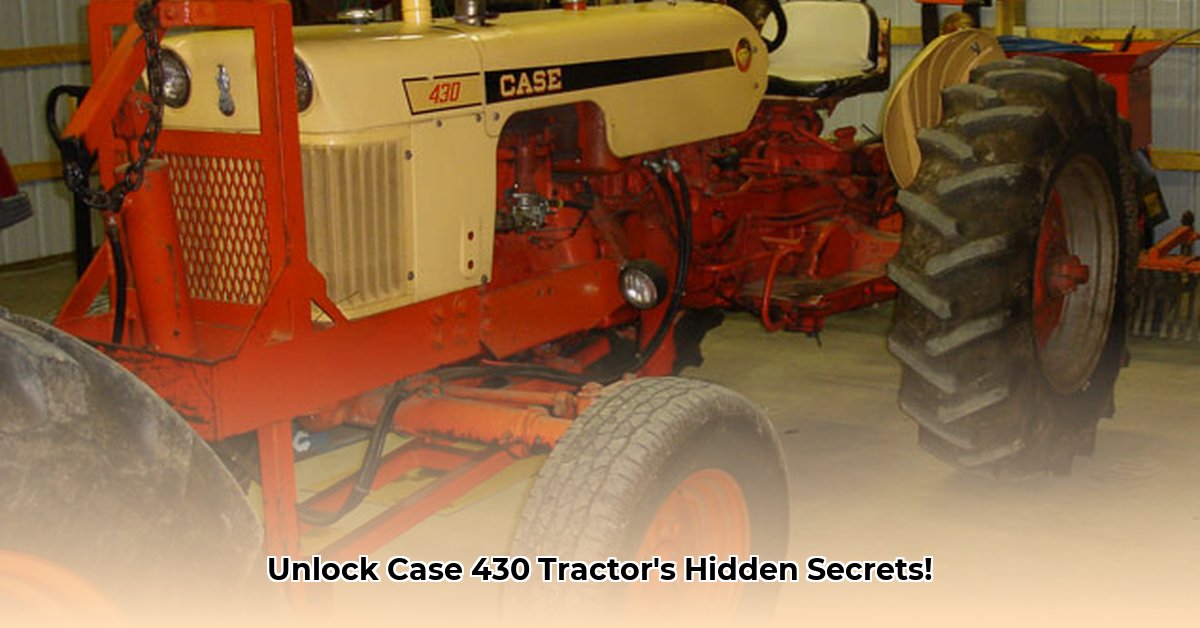
History and Background: A Legacy Forged in the Fields
The J.I. Case 430, a stalwart of the agricultural landscape from 1960 to 1969, represents a pivotal era in farming technology. This tractor wasn't just a machine; it was a symbol of progress, embodying the increasing mechanization of agriculture. Its robust build and versatility quickly established it as a farmer's favorite, capable of handling a wide range of tasks. The 430's enduring appeal today stems from its blend of practicality, reliability, and a distinct piece of agricultural history. But what precisely defined this iconic workhorse? Let's delve deeper. For more detailed specs, check out this Case 730 Specs.
Detailed Specifications: Unpacking the Case 430's Power
The Case 430's powerplant was a robust 3.1-liter four-cylinder diesel engine, providing ample power for its time. While precise torque figures remain elusive (research into original brochures is ongoing), the approximate 34 PTO horsepower speaks volumes about its capabilities. This isn't just about raw power; the engine's torque, or twisting force, was equally crucial for effective fieldwork. The transmission options varied, adding another layer of complexity to understanding the 430's story. Early models featured a simple, 4-speed unsynchronized gearbox. Later iterations offered a 12-speed unsynchronized transmission or an 8-speed mechanical shuttle shift— significant advancements for improved operator experience. Did you know that the lack of synchronization in these transmissions required greater operator skill? Understanding these nuances is essential for any Case 430 enthusiast.
Power take-off (PTO) options were typically available in 540 and 540/1000 RPM configurations, enabling compatibility with a range of implements. The hydraulic system is another area where more definitive spec data is still being gathered, but it was sufficient for the demands of its era. While power steering was optional (from around 1965), it was a highly sought-after feature that substantially enhanced ease of use. The Case 430 also featured the company's trademark Draft-o-Matic system, improving the user experience. A front-end loader was a common later addition, significantly boosting its versatility.
| Specification | Value | Notes |
|---|---|---|
| Engine | 3.1L Four-Cylinder Diesel | Precise torque specifications are still under research. |
| PTO Horsepower | ~34 hp | Approximate; varies slightly depending on configuration. |
| Transmission Options | 4-speed, 12-speed (unsynchronized), 8-speed shuttle shift | Shifting smoothness varied significantly between model years. |
| PTO Options | 540 and 540/1000 RPM | Exact offerings depended on the tractor's specific model and year. |
| Power Steering | Optional (approx. 1965 onwards) | A highly desirable feature for increased maneuverability. |
| Draft Control | Draft-o-Matic | A Case trademark feature enhancing ease of use. |
| Front-End Loader | Compatible (Optional, later models) | Added considerable versatility for some models. |
Performance and Capabilities: The Case 430 in Action
The Case 430 was a true workhorse, tackling everything from plowing and planting to haying tasks. Its power and hydraulics were well-suited to the typical farm operations of its time. However, limitations existed. The unsynchronized transmissions, while functional, demanded more skill from the operator than modern counterparts. Moreover, the open-station design meant operators were exposed to the elements—a less-than-ideal situation for long hours in the field. These factors must be considered when assessing its overall capabilities.
Restoration and Maintenance: Preserving a Piece of History
Owning a classic Case 430 is a rewarding experience, but it necessitates diligent care. Regular maintenance is paramount, focusing on the engine, transmission, hydraulics, and braking system. Sourcing parts can be challenging, but online communities dedicated to vintage tractors and specialized suppliers are invaluable resources. A proactive approach to maintenance ensures the longevity and continued enjoyment of this remarkable machine.
Market Value and Collectibility: Assessing Your Investment
The value of a Case 430 for collectors is determined by its condition, originality, and any additional features. Well-preserved tractors, boasting original paint and minimal modifications, command the highest prices. Online auctions, consultations with vintage tractor experts, and a thorough physical inspection are vital for accurate valuation.
Conclusion: A Timeless Classic
The Case 430's enduring appeal is undeniable. Its robust design, diverse transmission options, and innovative features for its time continue to captivate enthusiasts and historians alike. Understanding its detailed specifications allows for a deeper appreciation of this exceptional machine's place in agricultural history. Further research into its precise specifications is ongoing and will continue to enhance our understanding of this iconic tractor.